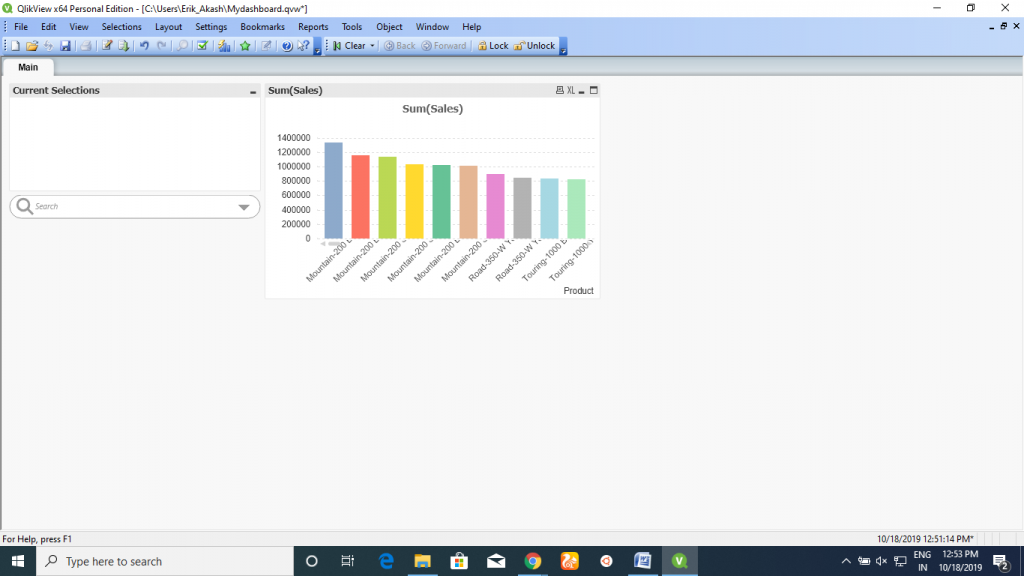QlikView Tutorial
What is QlikView?
QlikView is one of the best BI tools, according to the Gartner Magic Quadrant (a series of surveys published by Gartner). We can understand the role of QlikView in Business Intelligence, Qlikview helps to collect data from various data sources and analyze reports created with the functions of Qlikview. The best thing about this tool is that it provides a memory storage function that makes data collection, integration, and processing very fast.
Reports are generated using the tool, and the relationship between the data is automatically derived from the QlikView software. Subsequently, an important decision is made to favor the business by analyzing the management of the company. However, QlikView is a data collection tool that facilitates the creation of dynamic data analysis applications.
QlikView is a type of business discovery platform like MicroStrategy that provides BI (Business Intelligence) self-service for all business users in organizations. With QlikView, it is possible to analyze the data and use the results of the data to support the decision-making process. QlikView allows you to ask and answer your questions and follow your paths in-depth and allows you and your colleagues to make collaborative decisions.
At the heart of QlikView, there is a patented software engine that is own by its own, which generates new data views on the fly. QlikView compresses the data and saves it in memory, where it is available for immediate scanning of multiple users. For data sets too large to fit the memory, QlikView connects directly to the data source. QlikView offers an associative experience in all data used for analysis, regardless of where it is stored. You can start from wherever you want and go anywhere, and the best factor is that they are not limited to predefined drilling paths or preconfigured panels.
What is Business Intelligence Tools?
All the Business Intelligence tools are Design to provide services from the four main processes in BI. These four processes are integration, data collection, analysis, and data visualization — most of the latest Business Intelligence tools design to provide all of these functions.
QlikView in a look
While analyzing your data with QlikView, it is easy to perform tough tasks like spotting connections and make insights, and even when you are working with large and complex data sets.
You can combine information from various sources and easily make the information accessible in your network, ensuring that the right information reaches the right person. The associative data processing technology based on QlikView allows you to create a unique framework for interactive knowledge presentation and analysis.
It processes information in such a manner that just similar to the way the human brain works. Like the human brain, in data processing, it slowly makes associative associations. You don't need to determine what questions to ask. Only click on the product about which you want to know more.
Standard information search systems often require a top-down approach, while QlikView allows you to get started with any piece of data regardless of its location in the data structure
Recovering data in traditional systems is usually a complicated task that requires an extensive understanding of the structure of the databases and the syntaxes of the query language. The user is frequently limited to predefined search routines. QlikView revolutionizes this by making it possible to select freely from data displayed on the screen with a click of the mouse.
History of QlikView
QlikView is a tool developed by Qlik Tech. Before 1996 QlikView recognized as" Quick view, "where the term "quick "means quality, Understanding, Interaction, and Knowledge.
It was founded in 1993 in Sweden, and its headquarter is in Philadelphia; however, it's RnD division is still in Sweden.
In the present QlikView, offices have worldwide presence with the number of 1400 Employees, and it has the customer base of 28000 in 100 countries
In its management team, there are many well-known names of the BI Development industry and served companies like Oracle, Siebel, and SAP, etc.
Quickview is NOT a Business Intelligence tool but a business discovery tool. It maintains this distinction from other BI tools because of its flexibility. It is patented in-memory associative processing capability and because of its power collaboration and so many other cool features that we'll discuss further.
Qlikview acts like a human brain. The human brain works on association and can go into any direction to search the answer. Now the essential point to keep in mind is that it goes into any course to search for the answer, and because of this kind capability, it doesn't follow a predefined pattern to search for the answer, like Business Intelligence Tools.
How QlikView is different from other BI tools?
An interesting thing to keep in mind is that QlikView is not a standard BI tool. The reason is that it is primarily a data collection tool and, therefore, has some distinct characteristics. Now you have to wonder what exactly data discovery is. Data Discovery is a user-driven search for models and trends in data sets.
Help users understand and see these patterns by providing visual aids such as graphs, tables, maps, etc. QlikView is unique in its flexibility of operation, features in memory, and collaborative help.
Example
Suppose you have to access an employee's dashboard. In these kinds of cases, traditional Business Intelligence tools will first search for the regions, the country. Then it searches the department, and after performing all these steps, You may get to that targeted employee's dashboard. On the other hand, in QlikView, you don't have to perform all these steps. The required (or targeted ) employee can be directly searched. All these categories are independent of each other and cross-search. The flexibility of the tool is because of this reason.
How to Download QlikView
- Go to the official website of QlikView through this link:-
- Then go to the Products as shown in the image given below and click on the QlikView Personal Edition.
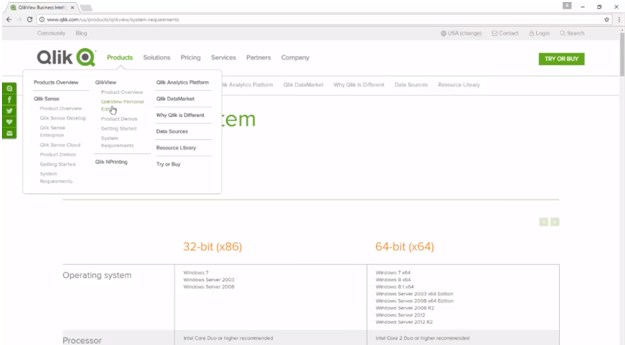
- You should be directed on this page, as shown below.
- Now Click on the FREE DOWNLOAD.
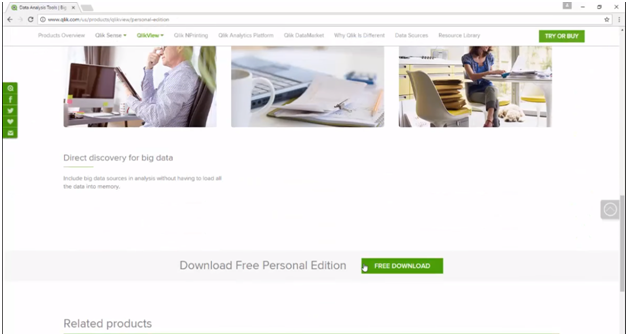
- After that, you have to fill up a form, as shown in below.
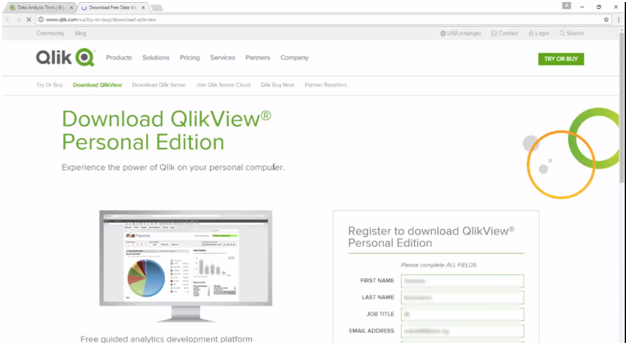
- When you are done with this form, click on the SEND FORM, and you are directed to the download page, as shown below.
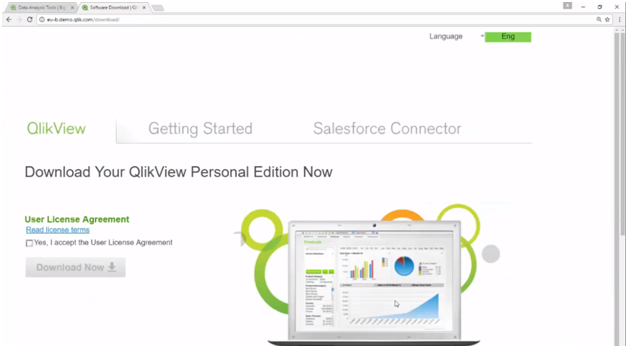
- Check the User Licence Agreement, then click on the download.
How to install QlikView
Once the Downloading completed, Follow these steps to install the QlikView.
1. Double click on the downloaded file and installation will start as shown below
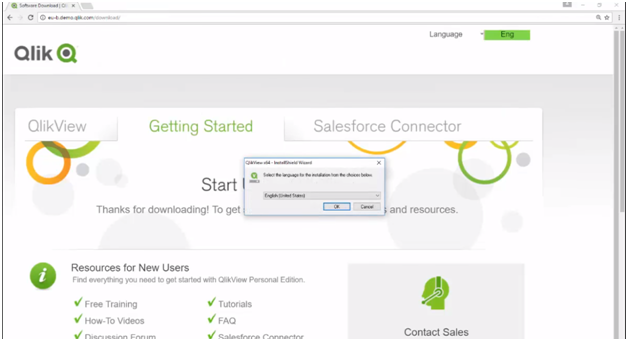
2. After choosing your language, then click on the OK Button
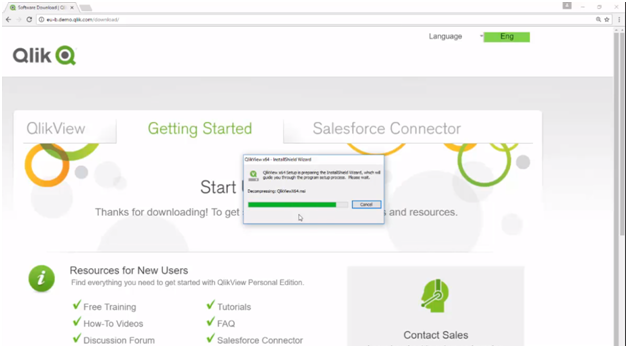
- Afterward, then click on NEXT, as shown in the given image below.
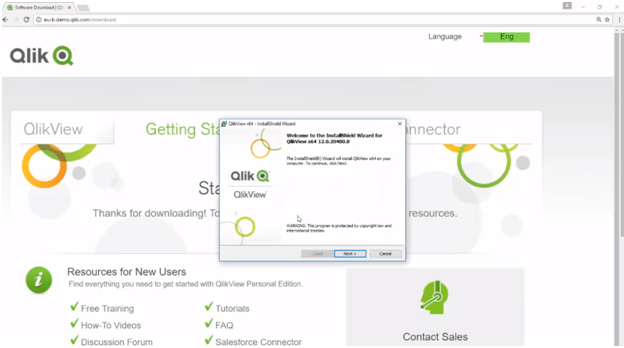
- Now click on the User License Agreement and click on the NEXT button, as shown in the image.
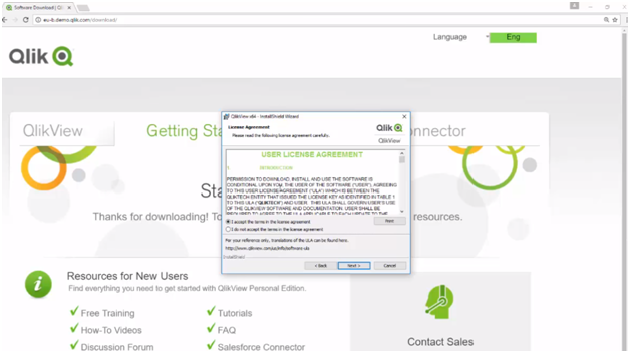
- Now enter the user name and click on the Next Button.
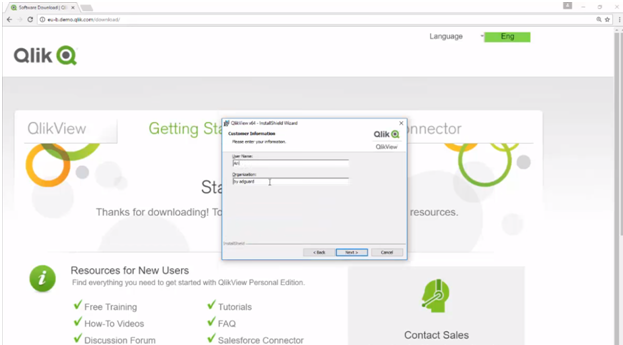
- Now it will ask you to to choose the directory or left the default.
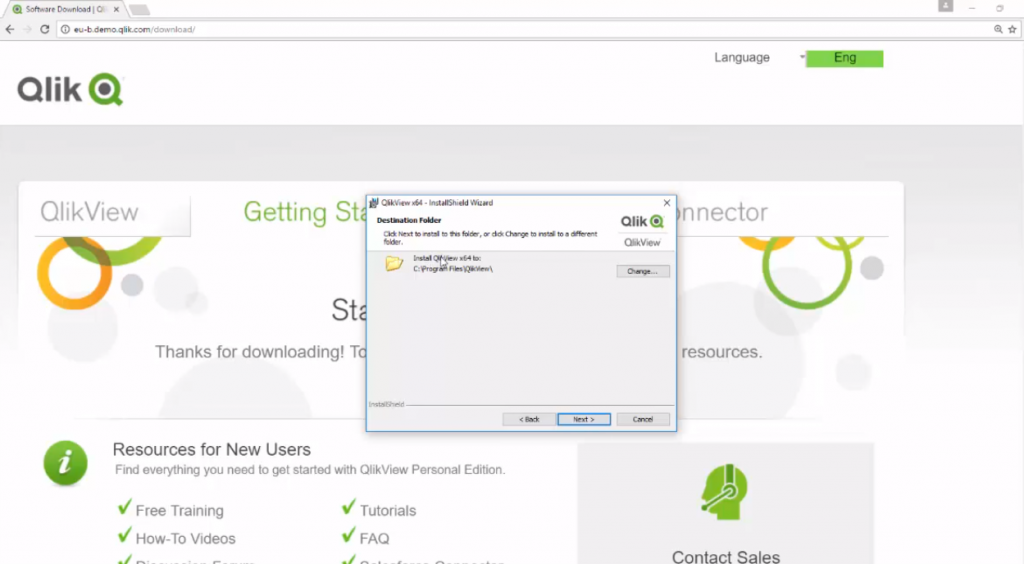
- Then click the NEXT button again, and it will ask you to choose an option among the following options, as shown in the given image, choose the option which fits in your requirements.
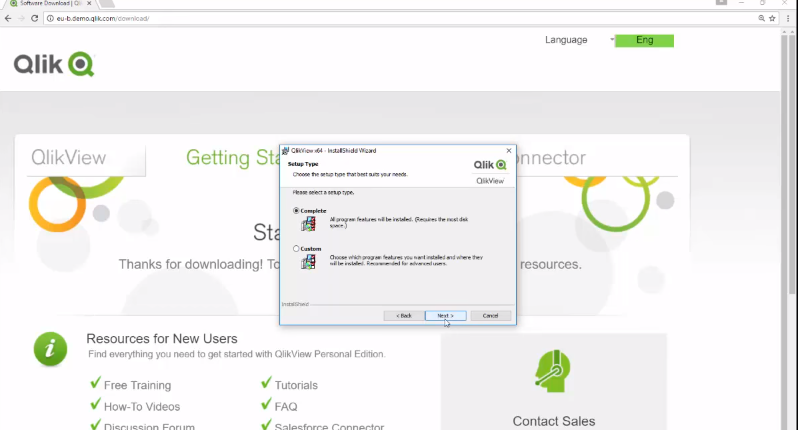
- Now click on NEXT Button; after clicking on the Next Button, it Finally asked you to INSTALL, so, without wasting time, click on the INSTALL option as shown below.
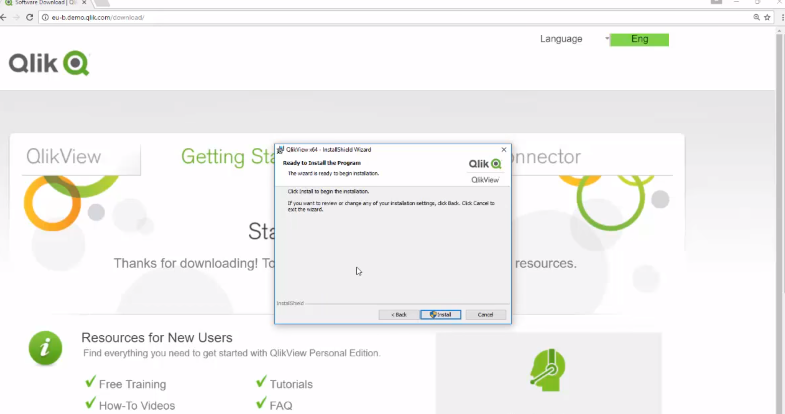
- It will take a couple of minutes to install, so just wait...
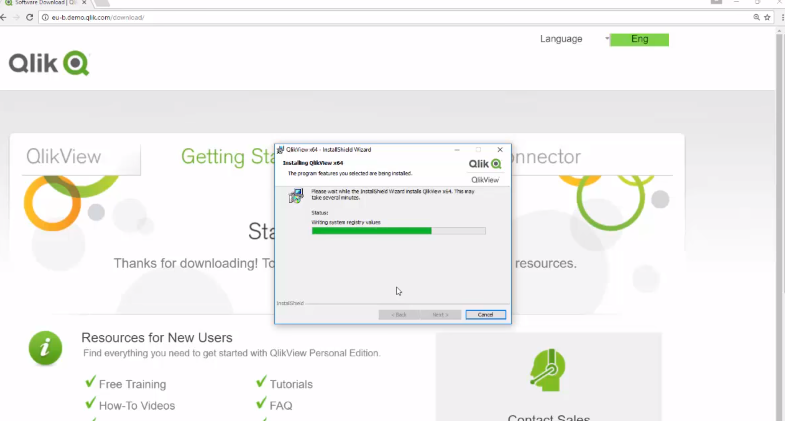
- Finally, it will ask you to FINISH the installation, so without wasting time, click on the FINISH option.
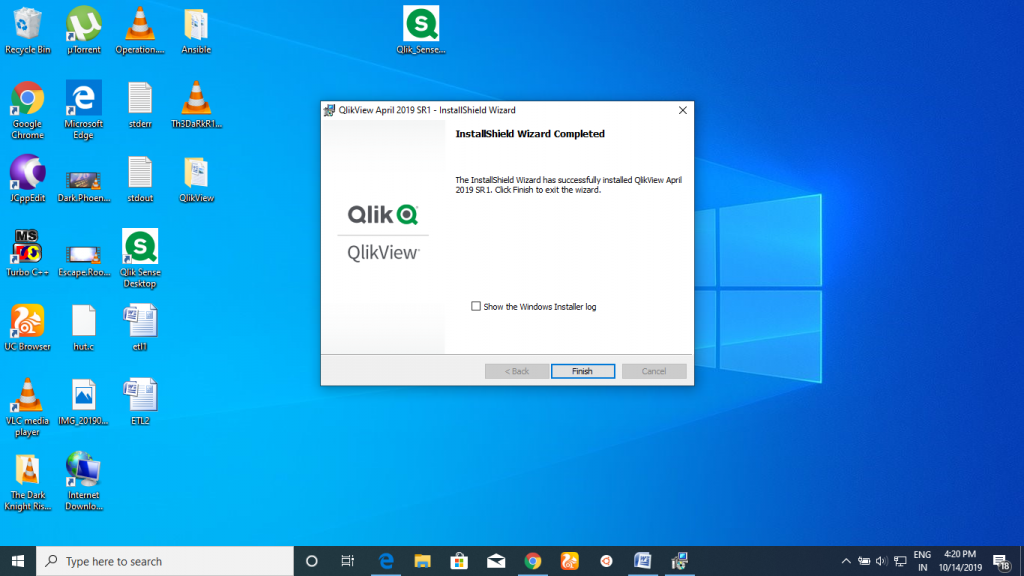
Components of QlikView
- Dashboard- It is a development platform to create reports.
- QlikView Server (QVS)- Acts as an interface between a client and the QlikView apps or backend system.
- QlikView Developer (QVD)- A Windows-based desktop tool.
- QlikView Publisher (QVP)- Responsible for data loading and distribution.
- Management Console- Centrally manages all aspects of the QlikView’s Environment. It has a web-based interface.
QlikView Architecture
QlikView’s architecture can be segregated (or categorized) in three components for better understanding:
- Front End
The front end of the presentation component is a browser-based platform in which applications are used to view documents sent by the editor and backend server. QlikView Server (QVS) acts as a mediator and manages the communication between the client and the backend system. Whenever a client requests a QlikView document (via the HTTP or QVP protocol), the server sends QlikView documents in .qvw format. The QVS is also responsible for customer safety.
· Back End
The application platform or backend has a QlikView developer where all Qlikview documents are created. Therefore, it has all the source documents. The format of documents with GUI support that are visible on the interface is .qvw or without GUI is .qvd (data-only file). All these documents go to the interface using QVP through the QlikView server. QlikView Publisher is responsible for loading data from all types of sources and distributing .qvw files using QlikView servers. Here, the Windows file system is responsible for all permissions and access permissions from different data sources.
· Infrastructure Resource
This is the fundamental level of QlikView architecture because it is the data access point. Data sources such as Microsoft Excel, Word, SAP, Oracle, Twitter, Facebook, and many other databases. This is in direct synchronization with the background system.
QlikView Features
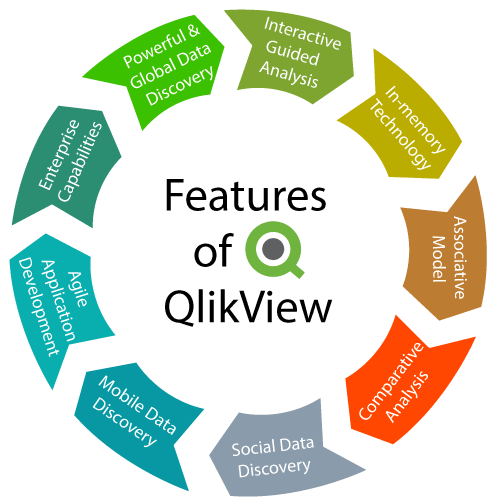
1. Powerful & Global Data Discovery
The ability to collect data efficiently is one of the powerful features of QlikView. QlikView performs a natural search through all available information. By natural research, we mean that the data search process does not follow predefined rules or schemes. Users can create applications and panels based on their needs. With these applications, they can perform a quick and simple process of data collection and analysis. QlikView allows fast, natural, and unrestricted data search and also provides easy partnerships and collaboration with many other data sources. This QlikView feature is compatible with a patented second-generation QIX engine of the QlikView software.
2. Interactive Guided Analysis
During the data collection process (interpretation of the collected data), the QlikView software helps the user by suggesting possible explanations. The software automatically suggests the most likely business trends and possible business models, which ensures better decision making. Basically, all users use QlikView to extract meaningful information from the ocean of data, and they don't lose any important points to analyze or understand with the guided help provided by the tool. This is facilitated by interactive panels and applications. QlikView also offers interesting visual tools such as charts, diagrams, tables, etc., to display data reports. The user has the full authority to customize these applications and panels accordingly.
- In-memory Technology.
Traditional Business Intelligence tools use the disk-based and query-based data storage and retrieval system, respectively. In such a data storage arrangement, the data is stored on external memory disks in an intermediate form (within the data warehouse in cubes), and queries are sent to retrieve the requested data. This process is very slow and tedious. While QlikView uses a new patented architecture in memory for data storage. All data from different sources (including traditional sources such as data stores) are loaded into the system RAM and are ready for recovery from there. Now, if any user using QlikView on the interface wishes to recover the data, it will be executed quickly from this file in memory. It offers the direct discovery of large data from sources such as Teradata, Cloudera without having to load complete data. QlikView is a pioneer of memory technology.
4. Associative Model
An associative data collection model is also exclusive to Qlikview. As we discussed in the QlikView introductory tutorial, traditional BI tools have a hierarchical approach to data search. This is not the case with Qlikview. In QlikView, all data fields are independent of each other and, at the same time, are linked together if relevance is desired.
Let's understand it with an example; let's say we have a movie database. It has fields like the name of the film, actors, and directors. In QlikView, if you want to get all the relevant information from Amitabh Bachchan, for example, about which movies did you work with, which directors did you work with? You just have to select the actor's name (Amitabh Bachchan in this case), and you will immediately get all the information about him on the board. You can customize the search as desired. Since you can select the name of a movie, say "Airlift," and in a few seconds, all the relevant information (such as actors in the film, director, etc.) will be displayed on Airlift (in the database). Here's how an associative model works in which all relevant data is automatically associated.
5. Comparative Analysis
It is one of the features of QlikView that helps in comparative analysis. It is an extension of the associative model. Through this, it is possible to compare different fields and data sets. Users or developers can select the sections or states of the data that can be compared. This comparison is assisted by tables, graphs, charts to understand better and analyze the compared data. With the help of this, one could see rare trends or exceptions in the business world. These features of Qlikview also provide software efficiency by helping the user obtain useful information about the data.
6. Social Data Discovery
The discovery of social data offers the sharing of information on individual data inside or outside groups. A user can add annotations as an addition to another person's ideas in a particular data report. Or you could also share data markers created by them to be seen by others. QlikView user interactivity is improved by providing this feature, as users can also participate in live discussion sessions to ensure a well-considered step in the direction of profit and business growth.
7. Mobile Data Discovery
QlikView supports mobile data detection with an HTML 5-enabled touch function that allows the user to search for data and perform data capture interactively and explore other server-based applications. QlikView software with touch functionality is available for mobile devices with operating systems such as Apple, Windows, and Android. The software works just like on a desktop PC or laptop. A specialized version is also available for small devices. On iOS (iPad and iPhone), a fully compatible version with advanced features provides all online access permissions, as well as the option to download and view offline.
8. Agile Application Development
QlikView is highly efficient in IT. Unlike traditional IT tools, where developers have had difficulty coding the changes that should be made in panels, reports, etc. The exclusive QlikView architecture has integrated frontend and backend, which has made coding for custom applications very simple without the need for professional skills. For this reason, the modification of different things using different products is finished, and only a centralized code framework can manage both the frontend and the backend. Furthermore, the company does not have to invest much in IT and human resources because the development of an application has become easier in QlikView. All necessary tools and features are provided within the software. Data models can be created in 15 days, and users can also quickly train to use them. It has proven to be a good way to save company time and resources.
Advantages of QlikView
- Dynamic BI Ecosystem- It provides a dynamic Business Intelligence ecosystem for the user.
- Data Security- The provision of instrument data security is very strict, and the creators guarantee the security of critical business data. The total guarantee of not violating security is given to the customer.
- Data Interpretation & Analysis- It’s dynamic and visual dashboards and applications help in quick and efficient data interpretation and also in analyzing.
- Data Sharing- Different teams can collaborate to take crucial decisions on data-driven information and interpretations. This collaboration is facilitated by the social analysis and real-time data sharing capability of Qlikview.
- Self-Service Tool- QlikView is a self-service BI tool, as it allows the user to work skillfully on the tool without relying on the IT department and blocking their workforce. To perform Changes in the dashboard and application do not require professional skills, and any non-technical employee of a company can work without problems with Qlikview. Any non-technical employee is able to operate click view without facing any problem too.
- Low Maintenance- The software implementation is very simple and hassle-free. Even in recent years, the software does not need much maintenance or technical supervision.
- Data Visualization- QlikView offers many options for displaying interesting and colorful data representation. Analytical reports generated using different types of pie charts, charts, bar charts, etc. They help users easily separate information in their heads. Because users can assign each color to a different attribute and not be confused with overwhelming information.
- Cost-QlikView is very cost-effective, mostly for small scale enterprises. A free trial is also available on the official site. The hardware required for Qlikview is also in affordable ranges.
Limitations of QlikView
- Less RAM Limit
QlikView is capable of handling massive data, but the computer’s RAM sets a limit. The size of the data load depends on the RAM of the system. The number of fields, cells, tables, and rows in the table also depends on the strength of the RAM of the device.
- Difficult Application Development
End-user application development is a little bit difficult because it requires technical expertise. App development and scriptwriting require someone who has good knowledge of SQL. To overcome this issue, the enterprise needs to hire professional developers or to train their existing employs
- Require Much Extra Purchase
At first, QlikView is affordable when compared to other Business Intelligence giants like congos; small –scale enterprises still find it pricey. Along with its base price, it demands a lot of extra purchases. This makes many small or even medium businesses switch to other affordable BI tools.
- Embedding
Integrating Qlikview with other software might seem a little odd as it has the very distinct appearance.
DASHBOARD
Qlikview Dashboard is basically a sheet or document that consists of different types of sheet objects that contain the data loaded into the QlikView script during loading. For example, a movie database will want to get the best possible information using QlikView tools.
How to create Dashboard in QlikView?
- Open the QlikView app.
- Click on New file.
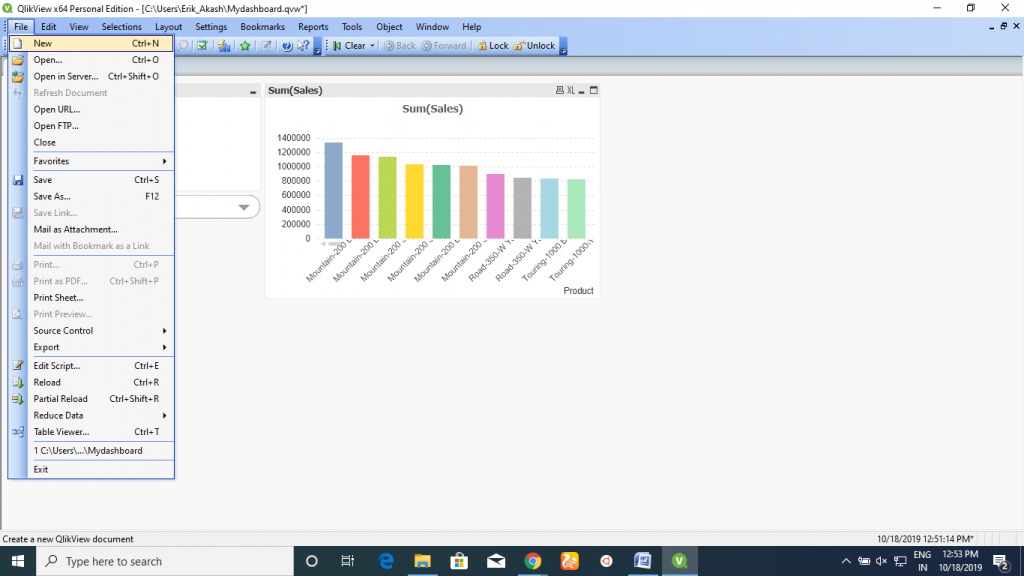
- Provide the path where your file is saved. Click on Browse for the path.
- Click on Next.
- Choose option Use column header from the data file. Click on Next.
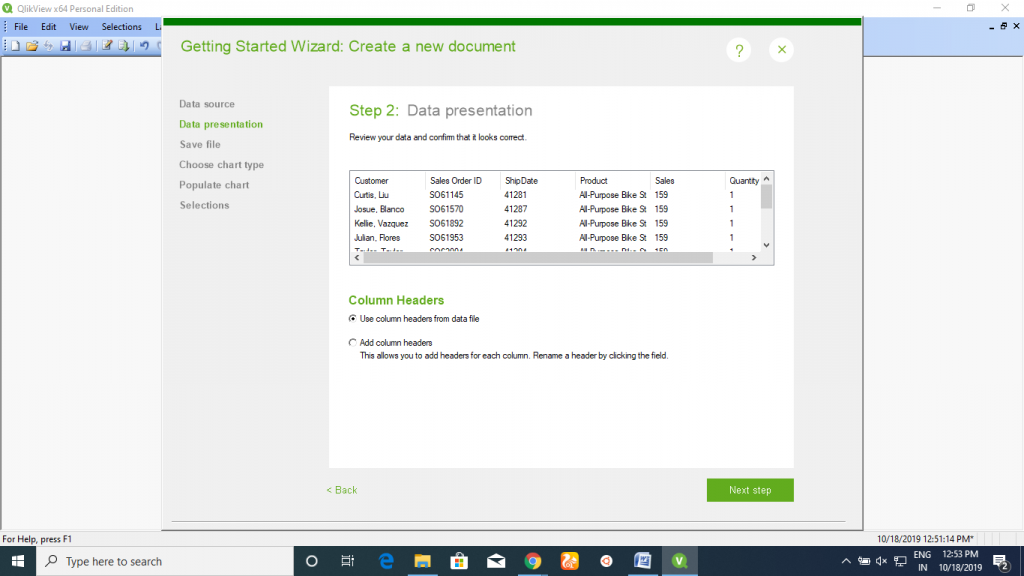
- Give the file name. Click on Next.
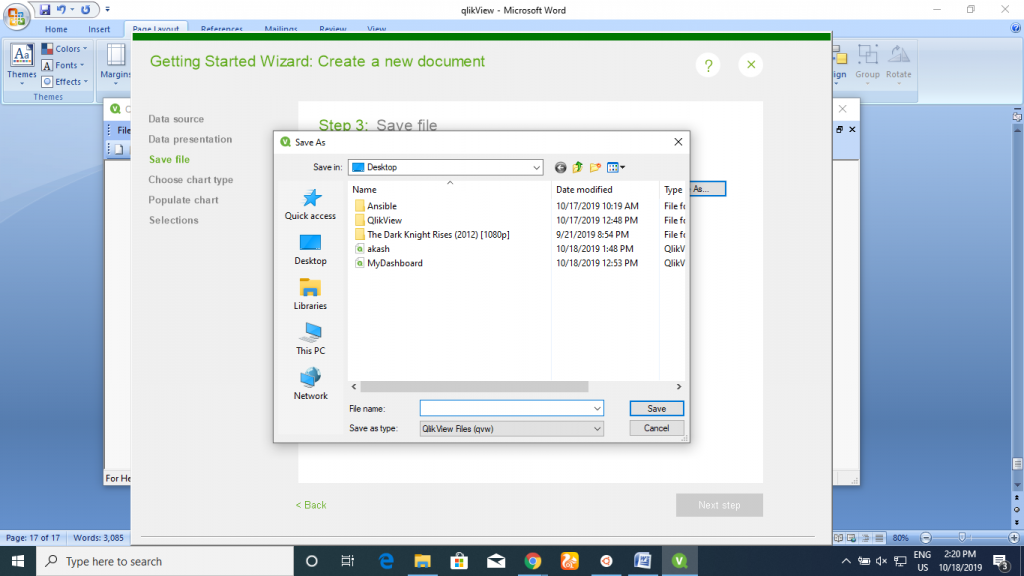
- Select the Chart type. Click on Next.
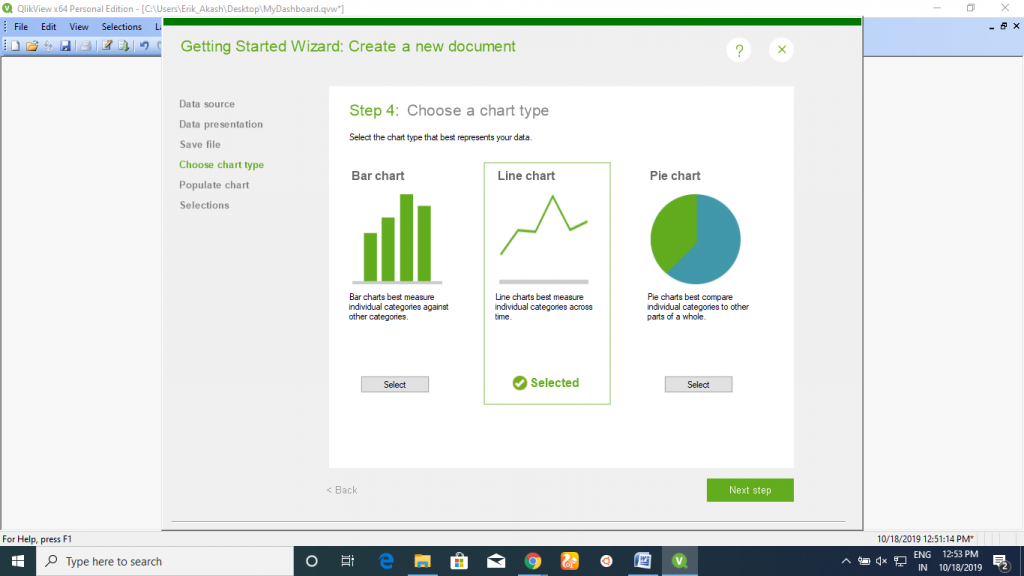
- Choose options from Dimension or Expression. Click on Next.
- And then click on Create.
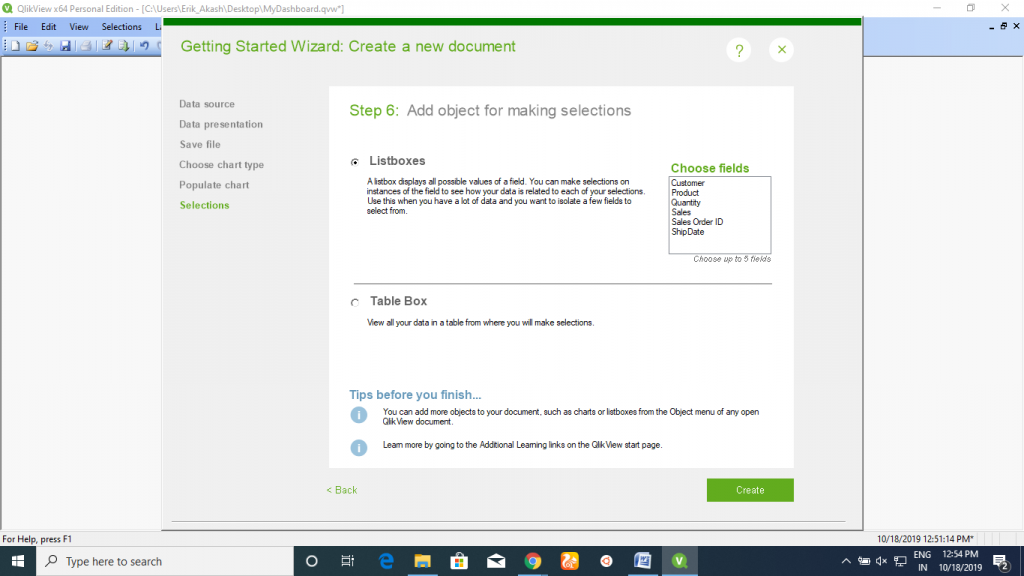
- When we click on Create, then Dashboard will look like this.
